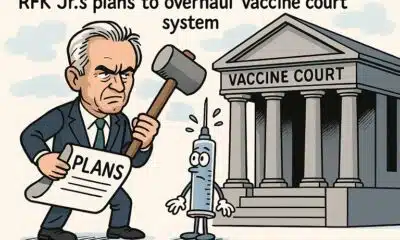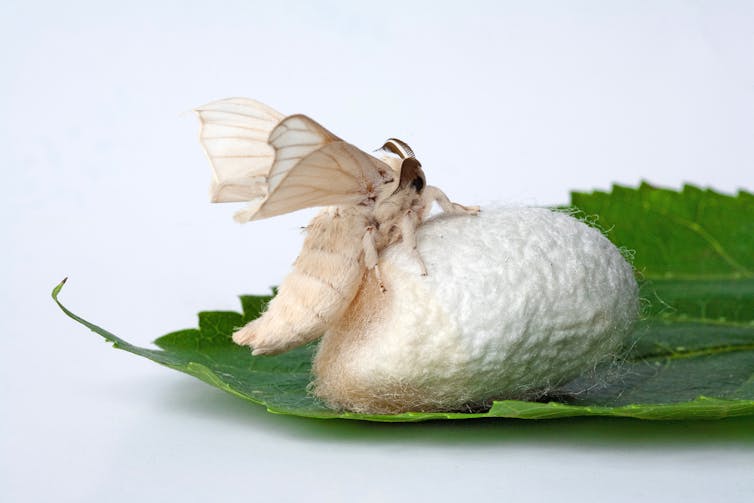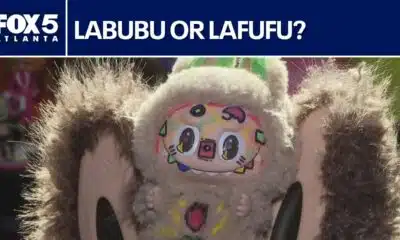
Daniela Duncan/Moment via Getty Images
Ella Kellner, University of North Carolina – Charlotte
Have you ever walked face-first into a spiderweb while on a hike? Or swept away cobwebs in your garage?
You may recognize the orb web as the classic Halloween decoration or cobwebs as close neighbors with your dust bunnies. These are just two among the many types of spiderweb architectures, each with a unique structure specially attuned to the spider’s environment and the web’s intended job.
While many spiders use their webs to catch prey, they have also evolved unusual ways to use their silk, from wrapping their eggs to acting as safety lines that catch them when they fall.
As a materials scientist who studies spiders and their silks, I am curious about the relationship between spiderweb architecture and the strength of the silks spiders use. How do the design of a web and the properties of the silk used affect a spider’s ability to catch its next meal?
Webs’ ancient origins
Spider silk has a long evolutionary history. Researchers believe that it first evolved around 400 million years ago. These ancestral spiders used silk to line their burrows, protect their vulnerable eggs and create sensory paths and guidelines as they navigated their environment.
To understand what ancient spiderwebs could have looked like, scientists look to the lampshade spider. This spider lives in rock outcroppings in the Appalachian and Rocky mountains. It is a living relative of some of the most ancient spiders to ever make webs, and it hasn’t changed much at all since web-building first evolved.

Tyler Brown, CC BY-SA
Aptly named for its web shape, the lampshade spider makes a web with a narrow base that widens outward. These webs fill the cracks between rocks where the spider can be camouflaged against the rough surface. It’s hard for a prospective meal to traverse this rugged landscape without being ensnared.
Web diversity
Today, all spider species produce silk. Each species creates its own specific web architecture that is uniquely suited to the type of prey it eats and the environment it lives in.
Take the orb web, for example. These are aerial, two-dimensional webs featuring a distinctive spiral. They mostly catch flying or jumping prey, such as flies and grasshoppers. Orb webs are found in open areas, such as on treelines, in tall grasses or between your tomato plants.
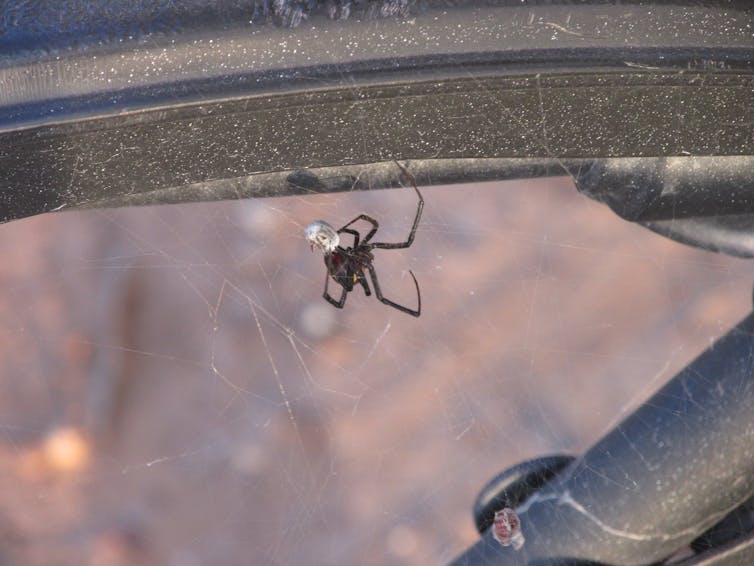
Karen Sloane-Williams/500Px Plus via Getty Images
Compare that to the cobweb, a structure that is most often seen by the baseboards in your home. While the term cobweb is commonly used to refer to any dusty, abandoned spiderweb, it is actually a specific web shape typically designed by spiders in the family Theridiidae. This spiderweb has a complex, three-dimensional architecture. Lines of silk extend downwards from the 3D tangle and are held affixed to the ground under high tension. These lines act as a sticky, spring-loaded booby trap to capture crawling prey such as ants and beetles. When an insect makes contact with the glue at the base of the line, the silk detaches from the ground, sometimes with enough force to lift the meal into the air.
Web weirdos
Imagine you are an unsuspecting beetle, navigating your way between strands of grass when you come upon a tightly woven silken floor. As you begin to walk across the mat, you see eight eyes peeking out of a silken funnel – just before you’re quickly snatched up as a meal.
Spiders such as funnel-web weavers construct thick silk mats on the ground that they use as an extension of their sensory systems. The spider waits patiently in its funnel-shaped retreat. Prey that come in contact with the web create vibrations that alert the spider a tasty treat is walking across the welcome mat and it’s time to pounce.
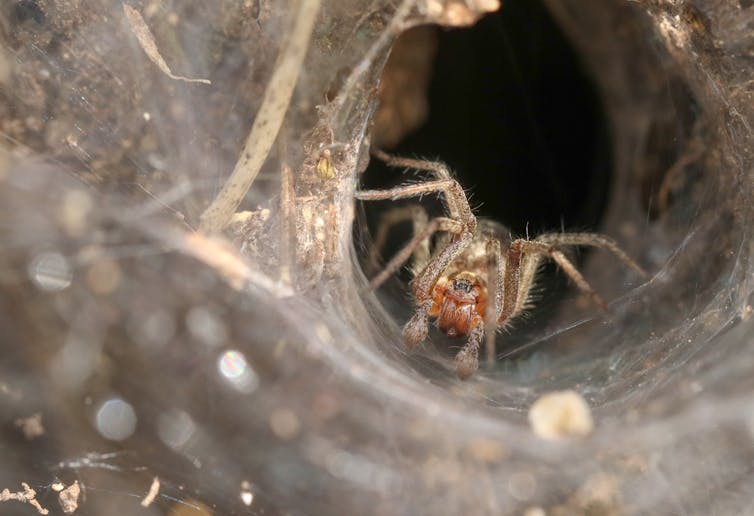
sandra standbridge/Moment via Getty Images
Jumping spiders are another unusual web spinner. They are well known for their varied colorations, elaborate courtship dances and being some of the most charismatic arachnids. Their cuteness has made them popular, thanks to Lucas the Spider, an adorable cartoon jumping spider animated by Joshua Slice. With two huge front eyes giving them depth perception, these spiders are fantastic hunters, capable of jumping in any direction to navigate their environment and hunt.
But what happens when they misjudge a jump, or worse, need to escape a predator? Jumpers use their silk as a safety tether to anchor themselves to surfaces before leaping through the air. If the jump goes wrong, they can climb back up their tether, allowing them to try again. Not only does this safety line of silk give them a chance for a redo, it also helps with making the jump. The tether helps them control the direction and speed of their jump in midair. By changing how fast they release the silk, they can land exactly where they want to.
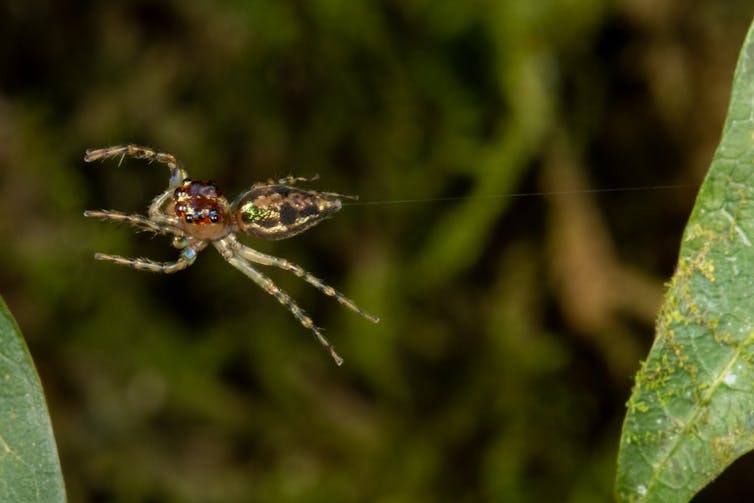
Fresnelwiki/Wikimedia Commons, CC BY-SA
To weave a web
All webs, from the orb web to the seemingly chaotic cobweb, are built through a series of basic, distinct steps.
Orb-weaving spiders usually start with a proto-web. Scientists think this initial construction is an exploratory stage, when the spider assesses the space available and finds anchor points for its silk. Once the spider is ready to build its main web, it will use the proto-web as a scaffold to create the frame, spokes and spiral that will help with absorbing energy and capturing prey. These structures are vital for ensuring that their next meal won’t rip right through the web, especially insects such as dragonflies that have an average cruising speed of 10 mph. When complete, the orb weaver will return to the center of the web to wait for its next meal.
The diversity in a spider’s web can’t all be achieved with one material. In fact, spiders can create up to seven types of silk, and orb weavers make them all. Each silk type has different material and mechanical properties, serving a specific use within the spider’s life. All spider silk is created in the silk glands, and each different type of silk is created by its own specialized gland.

Massimiliano Finzi/Moment via Getty Images
Orb weavers rely on the stiff nature of the strongest fibers in their arsenal for framing webs and as a safety line. Conversely, the capture spiral of the orb web is made with extremely stretchy silk. When a prey item gets caught in the spiral, the impact pulls on the silk lines. These fibers stretch to dissipate the energy to ensure the prey doesn’t just tear through the web.
Spider glue is a modified silk type with adhesive properties and the only part of the spiderweb that is actually sticky. This gluey silk, located on the capture spiral, helps make sure that the prey stays stuck in the web long enough for the spider to deliver a venomous bite.
To wrap up
Spiders and their webs are incredibly varied. Each spider species has adapted to live within its environmental niche and capture certain types of prey. Next time you see a spiderweb, take a moment to observe it rather than brushing it away or squishing the spider inside.
Notice the differences in web structure, and see whether you can spot the glue droplets. Look for the way that the spider is sitting in its web. Is it currently eating, or are there discarded remains of the insects it has prevented from wandering into your home?
Observing these arachnid architects can reveal a lot about design, architecture and innovation.
Ella Kellner, Ph.D. Student in Biological Sciences, University of North Carolina – Charlotte
This article is republished from The Conversation under a Creative Commons license. Read the original article.








